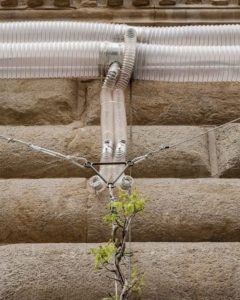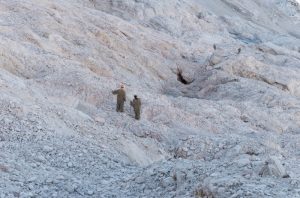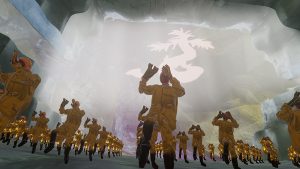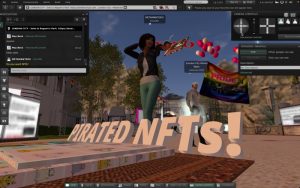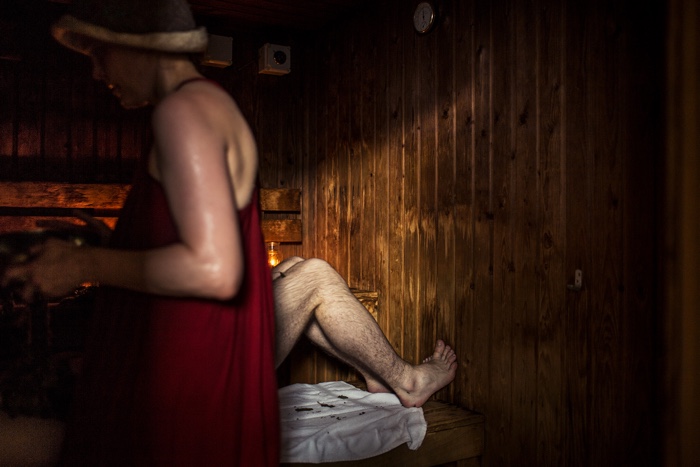
Mari Keski-Korsu, Beat to the Balance. Photography: Ross Fraser McLean / StudioRoRo for Edge Effects, Scottish Sculpture Workshop
Mari Keski-Korsu‘s work investigates how ecological and socio-economical changes manifest in everyday life. Her artistic research takes many forms: she took activists, artists and scientists on an expedition that delved into nuclear power, made some witty experiments in DIY climate manipulation, co-curated together with Petri Ruikka a whole edition of the Pixelache festival around the theme of empathy, shot a documentary that retraced the historical Finnish immigration routes to US, etc.
Over the past few years, her focus has been empathy. For the artist, empathy isn’t limited to a connection with other people and their emotional state. She is also interested in reaching out to the whole ecosystem humans are only a small part of. Throughout her performances, workshops and other works, she invites the public to discover how empathy with non-human and even non-animal species can be experienced through bodily presence, experimental communication as well as alternate visions of perception.
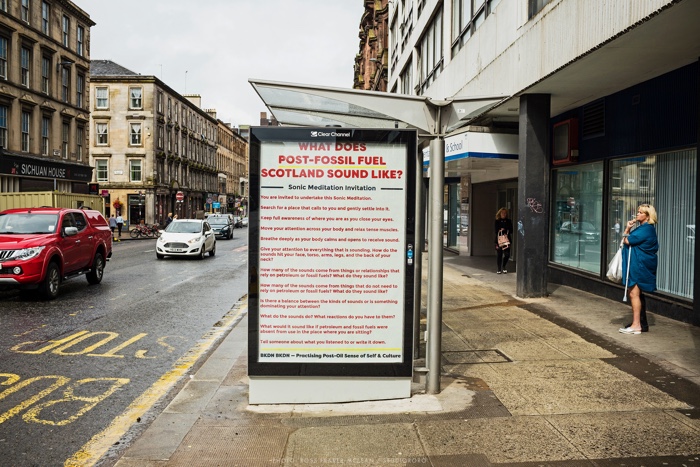
Scottish Sculpture Workshop – Frontiers in Retreat: Edge Effects at CCA in Glasgow. Photography: Ross Fraser McLean / StudioRoRo for Edge Effects, SSW
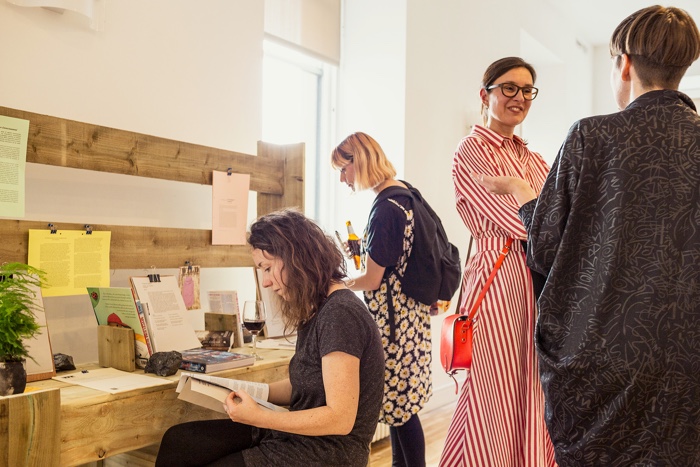
Scottish Sculpture Workshop – Frontiers in Retreat: Edge Effects at CCA in Glasgow. Photography: Ross Fraser McLean / StudioRoRo for Edge Effects, SSW
The artist is currently participating to the ongoing Edge Effects, a programme of workshops, walks, films and performances organized by the Scottish Sculpture Workshop at CCA and other venues in Glasgow this weekend. The event explores the co-dependencies between ecological, social, economic, and political phenomena.
Yesterday, Keski-Korsu invited Glaswegians and other guests of Edge Effect to a Beat to the Balance experience at Arlington Baths, a Victorian bath house founded in 1879. Beat to the Balance introduced participants to a ritualistic sauna practice which consists of whisking bodies with branch bundle of different tree species. The goal is to open energy flow and make more perceptible the interdependence between tree communities and humans. In the sauna with trees, self-care transforms into ourselves-care, kinship that could be an even stronger asset than warfare; it is a building block for the narrative of humanity.
If you read this post on time and are lucky enough to find yourself in Glasgow tomorrow, you can meet Mari Keski-Korsu at these two Edge Effects events: Regenerative Notes – Reflecting and Developing Empathetic Practices in Post-Fossil World and Holding Space with Trees Workshop. In the meantime, here’s a little online conversation i just had with Mari:
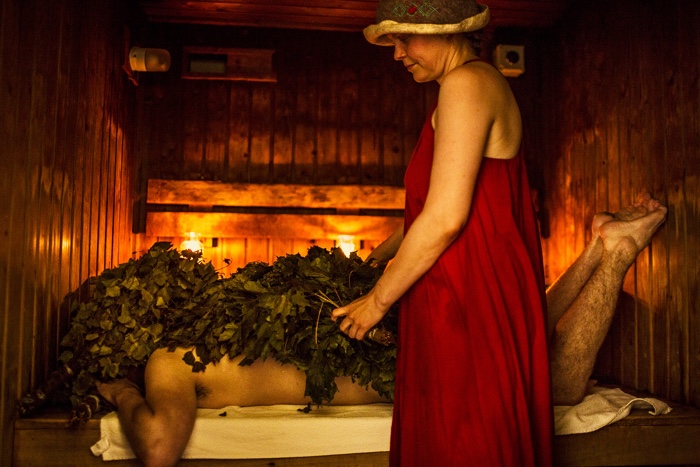
Mari Keski-Korsu, Beat to the Balance. Photography: Ross Fraser McLean / StudioRoRo for Edge Effects, SSW
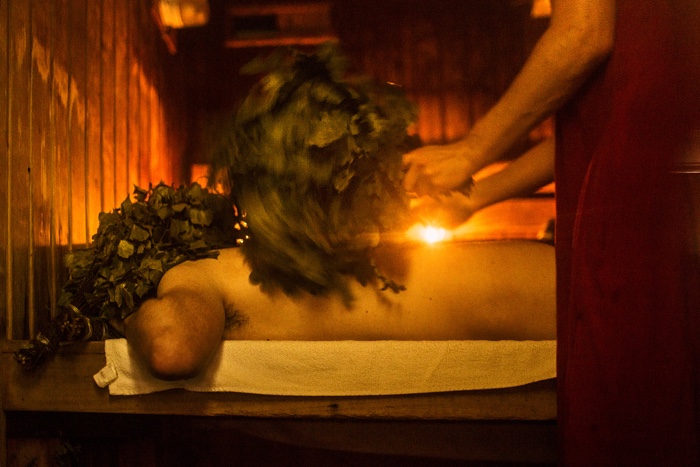
Mari Keski-Korsu, Beat to the Balance. Photography: Ross Fraser McLean / StudioRoRo for Edge Effects, SSW
Hi Mari! I was surprised to read that you actually studied to be a professional whisker. Apart from whipping people with tree branches, what does a session of whisking involve?
Whisking, tree leaves bathing, sauna ritual or holding space with trees; connecting with trees in the sauna can have many names in English. It doesn’t really include whipping people, although the touch of the leaves can be sometimes a bit fierce. To me, this ritual is a holistic, empathic space with trees and humans. But it naturally depends on the person entering it. Some think of it as a massage with different kinds of phyto- or aromatherapeutic benefits from the tree species, others receive it as a spiritual experience with the energies of the trees and connect very strongly with the forests. For some, it’s a total relaxation where your mind and body melts to the environment. Of course, it is also purifying as the sauna itself. Whisking can only happen in a sauna in the presence of warmth or steam – löyly – that has an etymology of a spirit. The steam opens up the person treated, the trees at hand and everyone inside the sauna.
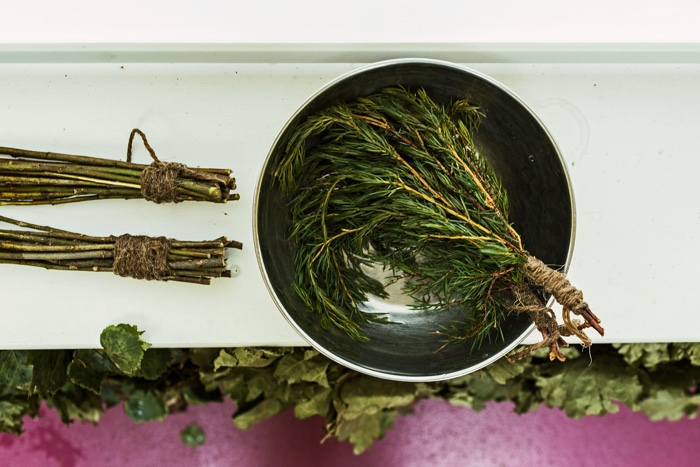
Mari Keski-Korsu, Beat to the Balance. Photography: Ross Fraser McLean / StudioRoRo for Edge Effects, SSW
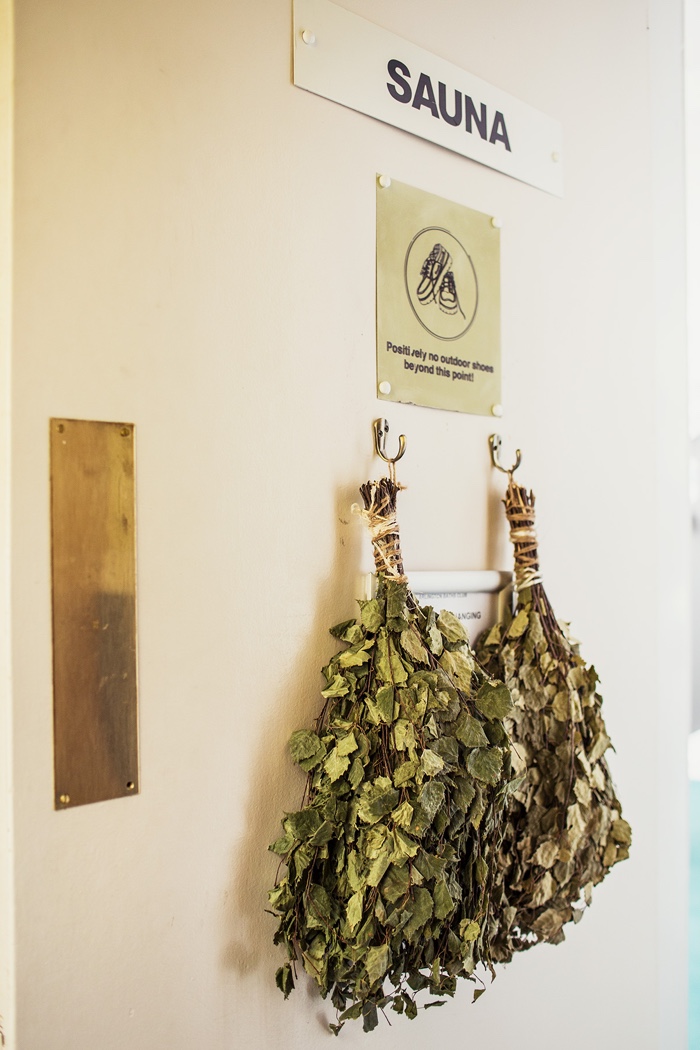
Mari Keski-Korsu, Beat to the Balance. Photography: Ross Fraser McLean / StudioRoRo for Edge Effects, SSW
Do Beat to the Balance treatments add something or depart from traditional whisking?
There is no such thing as “traditional whisking”, but there is tradition of whisking which has been kept alive in, for example, Finland, Baltic countries and Russia. In Finland, people usually whisk themselves with a birch whisk and whisking as a ritual or treatment for the other as I approach it, doesn’t exist either. The case is the same in most other sauna cultures. All the whiskers have their own styles and approaches, too. Beat to the Balance can sometimes include building a sauna together with the community like the sauna at the Scottish Sculpture Workshop or bringing sauna to places like the tent sauna in Astrid Noack’s Atelier inner yard where the community had had difficult times because of drug dealing and violence.
Sauna has been a place for healing and holistic health-care, it was the cleanest place in the household because of its temperature. Women gave birth in sauna because of this but also because it’s the perfect place to get the endorphins going; dark and warm like a safe cave, warm water always available. And when it was time to leave the Earth, the corpse was washed in the sauna for the last time. In between, sauna was a “poor man’s pharmacy” with all the plants. I’m interested in bringing the communal healing practice back to the sauna. The sauna already has a social power when we enter it naked and equal, but I also see it as a political power together with trees and humans – and even though many people don’t see as such nowadays, it does have a very strong spiritual meaning. All this is an asset that we can enhance.
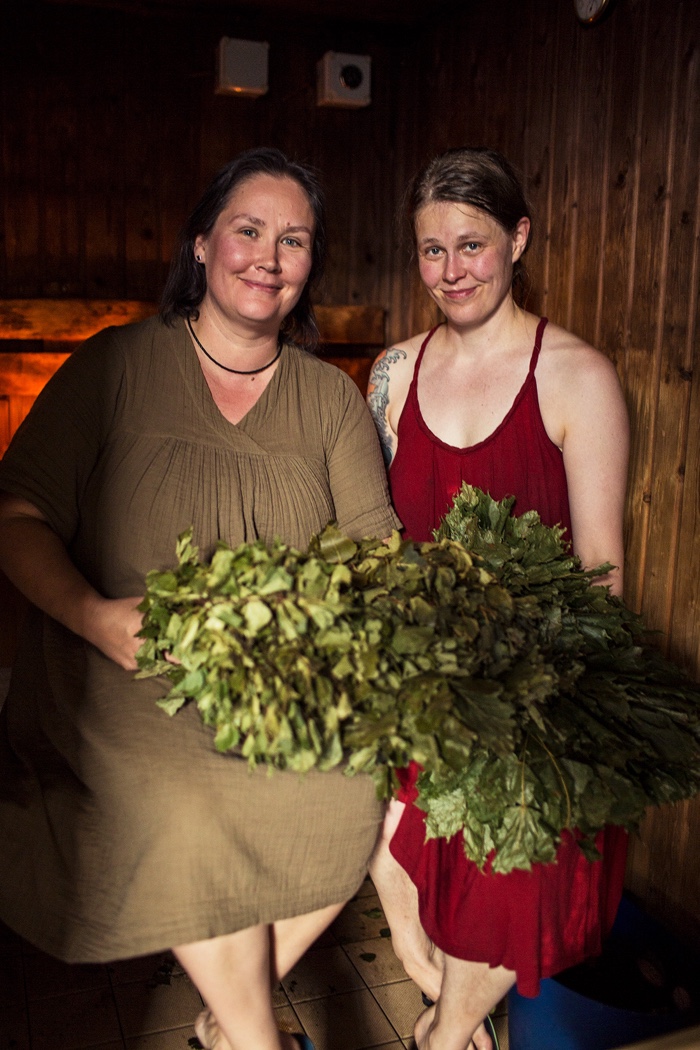
Mari Keski-Korsu, Beat to the Balance. Photography: Ross Fraser McLean / StudioRoRo for Edge Effects, SSW
Do you enter into the tree/individual relationship that Beat to the Balance seeks to create or do you stay outside of it, as someone who only facilitates the connection?
I am there to facilitate the connection but it’s not something I fully stay out of because it’s also the connection in between the two humans (or more) in the sauna. Before I start, I have a plan in mind where we should go – this is also a very practical thing: the sauna is a hot environment where one needs to work efficiently and take care of the safety of all parties. But in the framework, I go with the flow, listen to the trees and the person, what is needed at what point.
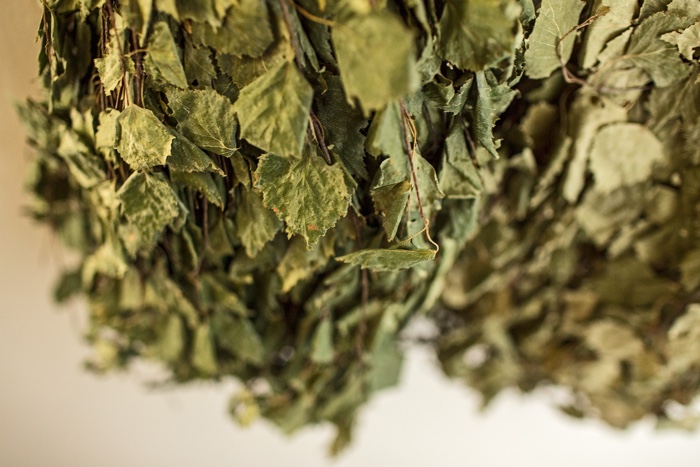
Mari Keski-Korsu, Beat to the Balance. Photography: Ross Fraser McLean / StudioRoRo for Edge Effects, SSW
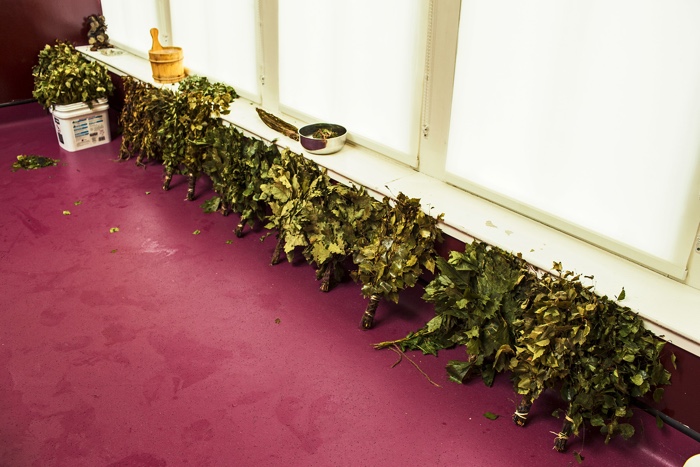
Mari Keski-Korsu, Beat to the Balance. Photography: Ross Fraser McLean / StudioRoRo for Edge Effects, SSW
The trees used in the sauna were Birch, Oak, Maple, Rowan and Juniper. Do the types of tree matter? Do you select them according to the species that are growing in a specific location or do they have special properties that better enable the tree-human connection?
The types of trees matter greatly. Any tree species and also other plants like herbs etc. can be used in sauna. The tree species one should avoid are of course the poisonous one but other than that, there’s no limitations. The trees have different ways they affect us, also different energies and depending on one’s physical, psychological or life situations, different trees support in different ways.
If I know in advance whom I’ll be treating, I prepare everything ready, think about the person or observe them and ask the forest what is needed. I do the same if I don’t know in advance but just on the spot without collecting branches and plants but with whisks made before. In addition to knowing the effects of tree species, there are also some simple physical matters: for example, trees with big leaves are good for moving the steam around in the sauna.
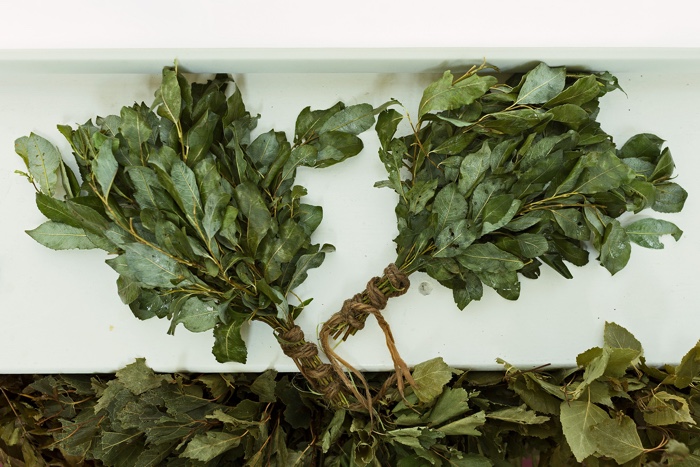
Mari Keski-Korsu, Beat to the Balance. Photography: Ross Fraser McLean / StudioRoRo for Edge Effects, SSW
I’m also curious about the fact that the description of the work talks about tree ‘communities’. Why should we think of trees in terms of communities?
I would like to ask you, what do you think a tree is? And what do you think a forest is?
My point of view, in some words maybe animistic, is that everything has a spiritual essence or some kind of consciousness, even though it doesn’t function the same way or is the same as human consciousness. The forests are interconnected ecosystems with vast networks of information transmitted with eg. with mycorrhizae rhizomes. Many tree species in the forest have common interests, and they are not necessarily competitors to each others.
I understand the worry with the anthropomorphism but on the other hand: we are humans and because of that our perspective is human (or maybe what our gut bacteria want). Scientist and author David George Haskell talks about this, too and I agree with him that it might be dangerous to project human concepts to the trees or forests, but it’s also stupid to totally reject the analogy between human minds and the networked flow of information within ecological communities. To me, working together with forests and trees brings an experience-based knowledge. It’s an empathetic practice where I imagine myself into the forest network. Then, it’s very hard to see anything just as a resource anymore.
To quote Haskell:
“Mind emerges from relationships among living cells. We experience one manifestation of these relationships inside the bony plates of our skulls. Other minds may exist within other living networks. To speak of a forest’s mind and intelligence, then, is not to impose caricatures of humanity on other species. Rather, our human experience of mind allows us to imagine what might be possible…”
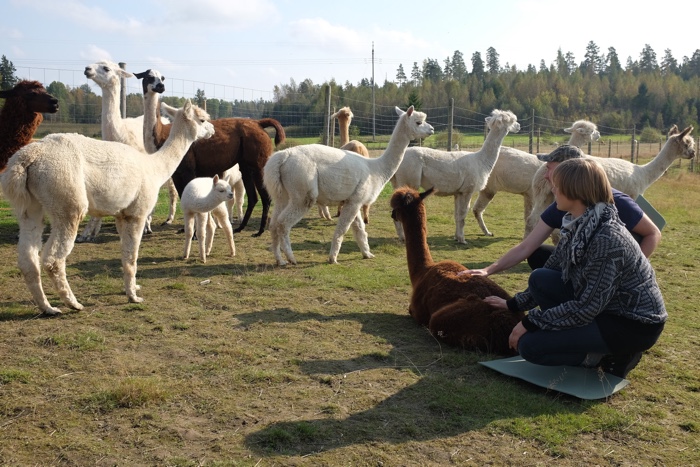
Mari Keski-Korsu, Alpaca Oracle, 2015. Photo by Antti Ahonen
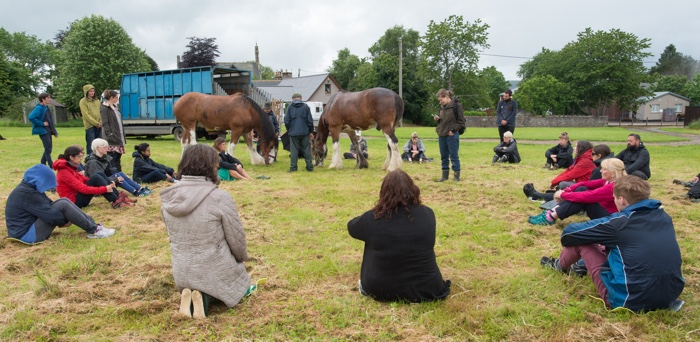
Mari Keski-Korsu, Clydesdale Oracle, 2015. Photo courtesy of Scottish Sculpture Workshop Lumsden
The work is part of a series of transdisciplinary inter-species communication works. Now let’s say i’m a very skeptical person (which i am actually) but want to participate to Beat to the Balance, Alpaca Oracle or Calling for the Others. Do you think i could still gain from the experience? Do participants need to enter into the performance with a specific mindset and openness?
It’s of course okay to be skeptical. But I would think one always needs some open-mindedness to even want to enter something that is out of their comfort zone. Sometimes you hear people saying: “I can’t even imagine that.” I think this is the key. If we can’t imagine something, it surely can’t happen. Everything is imagined first, including this narrative of humans we experience at the moment. Most of us live in the world of individualism and rationalism, and I’m aware of threads of pseudo-science but there’s also a strong discourse in the field of science about “alternative ways” to understand the world.
We are living the times of paradigm change and that is the time when opposing voices grow stronger. Modern science has existed for short time and it keeps bringing us good things. Indigenous cultures, holistic world views or other experience-based practices have been around for much longer. It’s also good to point out that these kind of experiences are not easily put into words, one just needs to have them.
I welcome them with open arms since I do believe there are much crazier things happening in the world that are putting our species, along with many others, in severe risk of extinction.
I invite you to place yourself in a situation where you imagine equality between eg. companion species or trees. This happens trough empathy. It’s difficult for us to imagine this because if it happens, we would be forced to change things in our lives immediately.
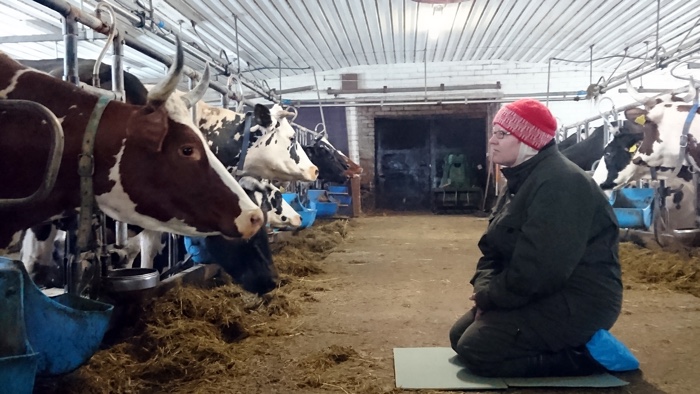
Mari Keski-Korsu, Oracle. Photo by Mari Keski-Korsu
Works like Alpaca Oracle and Clydesdale Oracle aim to ask help and advice for humankind from other animals. Could you give us some examples of what participants have learnt from their participation in these works? Can the experience be replicated and applied to other contexts once the participants go back home?
People of course have different kinds of experiences, one of being guided to the situation I described. Many times, people are first very judgmental of their own experience and they can’t believe in it. But this is about being aware and listening to the smallest nuances and what they mean to the participants.
In the Oracles, I have worked with companion species that are also herd animals like humans are too. In the so-called Western culture, we have accepted the idea of being individual, every person for themselves, survival of the fittest and so on. We often forget that all the flourishing or success of human species is based on collaboration and the collaboration is based on empathy.
From just looking at the well-being of ourselves or those who are very close to us, we should look at the well-being all humans, all species and all ecosystems. This can be achieved by learning empathy and enhancing it. As one example for this, a participant in the Oracles said that during the session, they learnt to listen to the herd and be less of a predator. When you suddenly realise there was an interconnection and a message received, it is a very surprising moment for everyone and it creates an atmosphere of respect and an understanding of interconnectedness. Some participants have continued to practice the experiments on their own, of course. From my point of view, it has brought me back to something I knew as a way of life when I was a child and I’ve been so happy to re-learn again. It changed how I experience the world. Maybe we could consider these practices as self-help but I also think they are more than that. It’s active doing, focused practice with aims.
Mari Keski-Korsu and Grit Ruhland, Calling for the Others, recorded at Agrikultura, in Hyllie, Malmö, 2017
I’m quite curious about a sentence you wrote in the description of Calling for the Others: “The others who are called, could of course be cattle but the idea is to call any members of flora & fauna, other entities and everything in between (i.e technology).” What is the role and technology here? I thought it was partly responsible for our disconnection from the non-human world?
I also think that technology is partly responsible for the disconnection but at the same time, I wish that the existing technology could be used more wisely, efficiently and empathically. Could this happen if we try to reach our awareness and understand holistically how, for example, a car came into being? What natural resources were used to make it and what were the processes? What it requires to exist and function in those terms? Can this be a bodily experience? We tried this out in the Calling for the Others sessions by moving with the cars in the highway, letting their sound hit our bodies and place our bodies as they wish.
This created a contrast that underlines the fact that these are the environments where we spend most of our time. To me, empathic inter-species communication is not about going to some remote place where we can think that nature exists and humans haven’t disturbed the peace of it. I don’t believe in the concept of nature, as some separate entity from humans. To my understanding, we need to learn and practice the communication skills regardless of these contrasts and in the environments where we live. These environments and cultures include technology – technology being not only the gadgets, factory farms or cars but the very first time a fire was lit or an axe was swung.
How does the work address the questions explored by the Edge Effects program: What multiple forms of knowledge, discourse, and models of action would construct a viable future for humans and other forms of life? What kinds of boundaries should be dismantled, so that change in the direction of an ecologically sustainable future could be possible?
In the crisis of humanity, among the skills we need to become more aware of, (re)learn and embrace is an ability to nurture deeper connections and emphatic communication with other species & entities in the ecosystems we live in, to respect the interconnectedness of all. To my understanding, we need this to change the narrative of humans. Through the empathic view, Homo Empathicus is destined to see everything differently; we can’t keep lavishly exploiting the natural resources of this planet and every species, including the human one, living on it.
Thanks Mari!
Beat to the Balance is part of Scottish Sculpture Workshop – Frontiers in Retreat: Edge Effects which takes place until Sunday 30 July 2017 at CCA: Centre for Contemporary Arts and venues across the city of Glasgow.
Edge Effects marks the conclusion of the five year Frontier in Retreat programme and is presented through a series of eight satellite exhibitions taking place across Europe between July and December 2017 and in Seoul in 2018.
Previously by Mari Keski-Korsu: Albedo Dreams. Experiments in DIY climate manipulation.
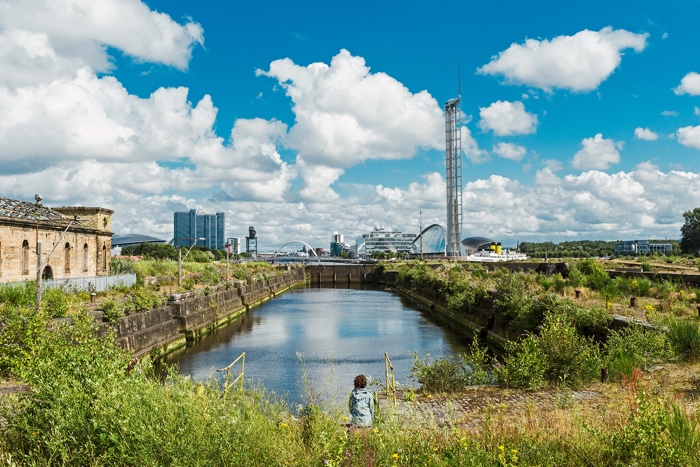
Scottish Sculpture Workshop – Frontiers in Retreat: Edge Effects at CCA in Glasgow. Photography: Ross Fraser McLean / StudioRoRo for Edge Effects, SSW
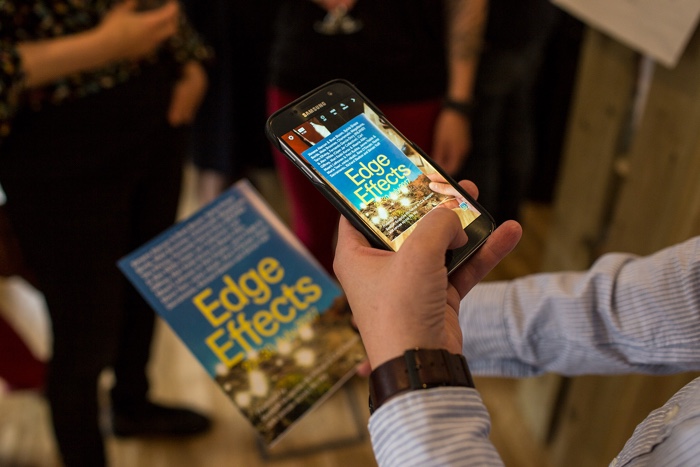
Scottish Sculpture Workshop – Frontiers in Retreat: Edge Effects at CCA in Glasgow. Photography: Ross Fraser McLean / StudioRoRo for Edge Effects, SSW


